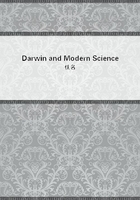
第158章
"Mr A.R. Wallace from his old travelling companion the Author."Only a year and a half after the publication of the "Origin", we find that Darwin wrote to Bates on the subject which was to provide such striking evidence of the truth of Natural Selection: "I am glad to hear that you have specially attended to 'mimetic' analogies--a most curious subject; Ihope you publish on it. I have for a long time wished to know whether what Dr Collingwood asserts is true--that the most striking cases generally occur between insects inhabiting the same country." (The letter is dated April 4, 1861. "More Letters", I. page 183.)The next letter, written about six months later, reveals the remarkable fact that the illustrious naturalist who had anticipated Edward Forbes in the explanation of arctic forms on alpine heights ("I was forestalled in only one important point, which my vanity has always made me regret, namely, the explanation by means of the Glacial period of the presence of the same species of plants and of some few animals on distant mountain summits and in the arctic regions. This view pleased me so much that Iwrote it out in extenso, and I believe that it was read by Hooker some years before E. Forbes published his celebrated memoir on the subject. In the very few points in which we differed, I still think that I was in the right. I have never, of course, alluded in print to my having independently worked out this view." "Autobiography, Life and Letters", I. page 88.), had also anticipated H.W. Bates in the theory of Mimicry: "What a capital paper yours will be on mimetic resemblances! You will make quite a new subject of it. I had thought of such cases as a difficulty; and once, when corresponding with Dr Collingwood, I thought of your explanation; but I drove it from my mind, for I felt that I had not knowledge to judge one way or the other." (The letter is dated Sept. 25, 1861: "More Letters", I. page 197.)Bates read his paper before the Linnean Society, Nov. 21, 1861, and Darwin's impressions on hearing it were conveyed in a letter to the author dated Dec. 3: "Under a general point of view, I am quite convinced (Hooker and Huxley took the same view some months ago) that a philosophic view of nature can solely be driven into naturalists by treating special subjects as you have done. Under a special point of view, I think you have solved one of the most perplexing problems which could be given to solve." ("Life and Letters", II. page 378.) The memoir appeared in the following year, and after reading it Darwin wrote as follows, Nov. 20, 1862: "...In my opinion it is one of the most remarkable and admirable papers I ever read in my life...I am rejoiced that I passed over the whole subject in the "Origin", for I should have made a precious mess of it. You have most clearly stated and solved a wonderful problem...Your paper is too good to be largely appreciated by the mob of naturalists without souls; but, rely on it, that it will have LASTING value, and I cordially congratulate you on your first great work. You will find, I should think, that Wallace will fully appreciate it." ("Life and Letters", II. pages 391-393.) Four days later, Nov. 24, Darwin wrote to Hooker on the same subject: "I have now finished his paper...' it seems to me admirable. To my mind the act of segregation of varieties into species was never so plainly brought forward, and there are heaps of capital miscellaneous observations." ("More Letters", I. page 214.)Darwin was here referring to the tendency of similar varieties of the same species to pair together, and on Nov. 25 he wrote to Bates asking for fuller information on this subject. ("More Letters", I. page 215. See also parts of Darwin's letter to Bates in "Life and Letters", II. page 392.) If Bates's opinion were well founded, sexual selection would bear a most important part in the establishment of such species. (See Poulton, "Essays on Evolution", 1908, pages 65, 85-88.) It must be admitted, however, that the evidence is as yet quite insufficient to establish this conclusion. It is interesting to observe how Darwin at once fixed on the part of Bates's memoir which seemed to bear upon sexual selection. Areview of Bates's theory of Mimicry was contributed by Darwin to the "Natural History Review" (New Ser. Vol. III. 1863, page 219.) and an account of it is to be found in the "Origin" (Edition 1872, pages 375-378.)and in "The Descent of Man". (Edition 1874, pages 323-325.)Darwin continually writes of the value of hypothesis as the inspiration of inquiry. We find an example in his letter to Bates, Nov. 22, 1860: "Ihave an old belief that a good observer really means a good theorist, and Ifully expect to find your observations most valuable." ("More Letters", I. page 176.) Darwin's letter refers to many problems upon which Bates had theorised and observed, but as regards Mimicry itself the hypothesis was thought out after the return of the letter from the Amazons, when he no longer had the opportunity of testing it by the observation of living Nature. It is by no means improbable that, had he been able to apply this test, Bates would have recognised that his division of butterfly resemblances into two classes,--one due to the theory of mimicry, the other to the influence of local conditions,--could not be sustained.